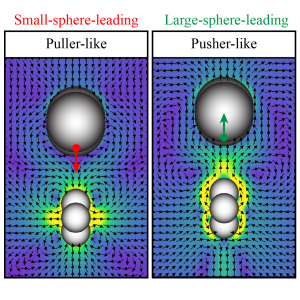Klotsa group latest article picked as editor’s suggestion
 In a new article published in Physical Review Fluids, and selected as editor’s suggestion, graduate student Thomas Dombrowski and Prof. Daphne Klotsa computationally studied the kinematics of a simple reciprocal model swimmer (asymmetric dumbbell) in a Newtonian fluid as a function of the Reynolds number (Re). They investigated how the onset and gradual increase of inertia impacts swimming behavior, specifically a reversal in the swim direction, flow field, and the swim stroke. They divided the swim stroke into the increase and decrease in the distance between the two spheres (expansion and compression respectively) and related them to power and recovery strokes. They found that the switch in swim direction also corresponds to a switch in power and recovery strokes. They obtained expressions for the mean swimming velocity by collapsing the net displacement during expansion and compression under power-law relationships with respect to Re, the swimmer’s amplitude, and the distance between the two spheres. Analyzing the fluid flows, they saw that the averaged flow field during expansion always resembles a pusher and during compression it always resembles a puller, but when averaged over the whole cycle, the flow that dominates is the one that occurs during the power stroke. They also related the power and recovery strokes to the swimming efficiency during times of expansion and compression, and found that the power stroke is, surprisingly, not always more efficient than the recovery stroke. Their results may have important implications in biology and ultimately the design of artificial swimmers.
In a new article published in Physical Review Fluids, and selected as editor’s suggestion, graduate student Thomas Dombrowski and Prof. Daphne Klotsa computationally studied the kinematics of a simple reciprocal model swimmer (asymmetric dumbbell) in a Newtonian fluid as a function of the Reynolds number (Re). They investigated how the onset and gradual increase of inertia impacts swimming behavior, specifically a reversal in the swim direction, flow field, and the swim stroke. They divided the swim stroke into the increase and decrease in the distance between the two spheres (expansion and compression respectively) and related them to power and recovery strokes. They found that the switch in swim direction also corresponds to a switch in power and recovery strokes. They obtained expressions for the mean swimming velocity by collapsing the net displacement during expansion and compression under power-law relationships with respect to Re, the swimmer’s amplitude, and the distance between the two spheres. Analyzing the fluid flows, they saw that the averaged flow field during expansion always resembles a pusher and during compression it always resembles a puller, but when averaged over the whole cycle, the flow that dominates is the one that occurs during the power stroke. They also related the power and recovery strokes to the swimming efficiency during times of expansion and compression, and found that the power stroke is, surprisingly, not always more efficient than the recovery stroke. Their results may have important implications in biology and ultimately the design of artificial swimmers.

